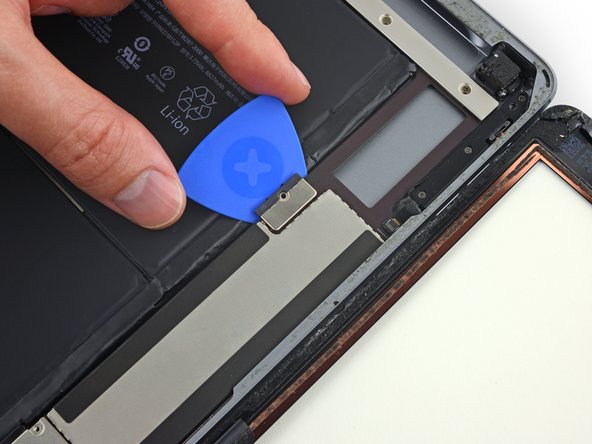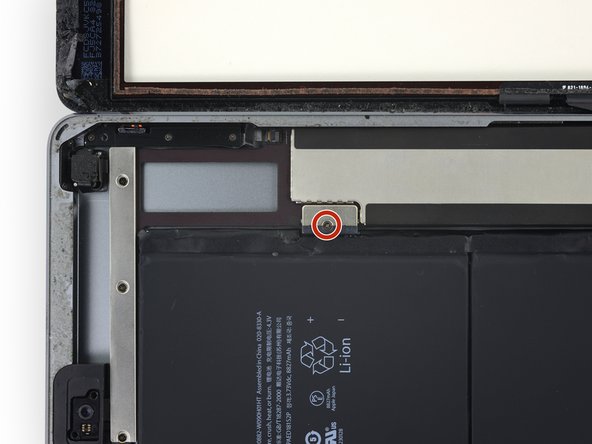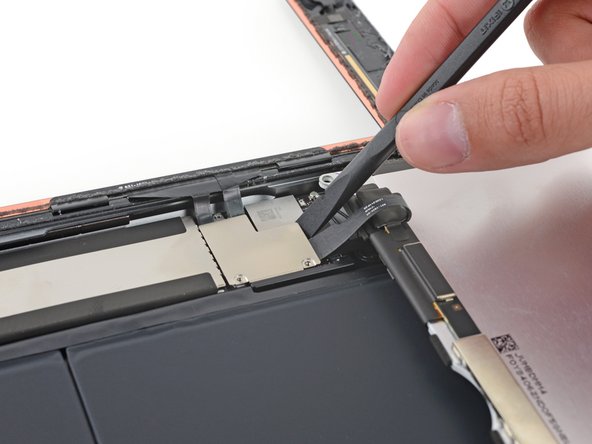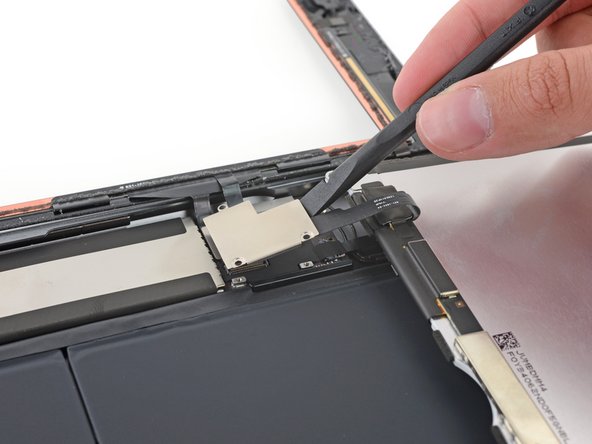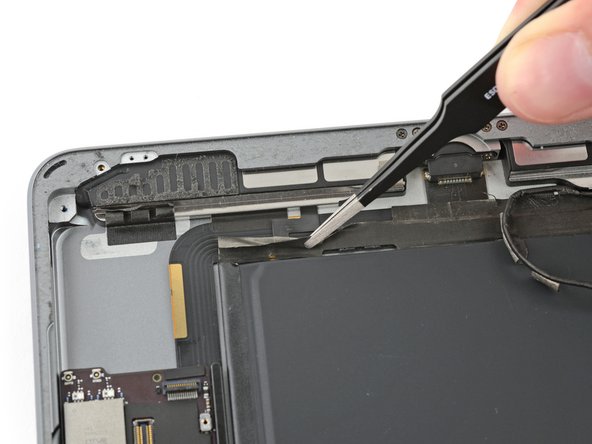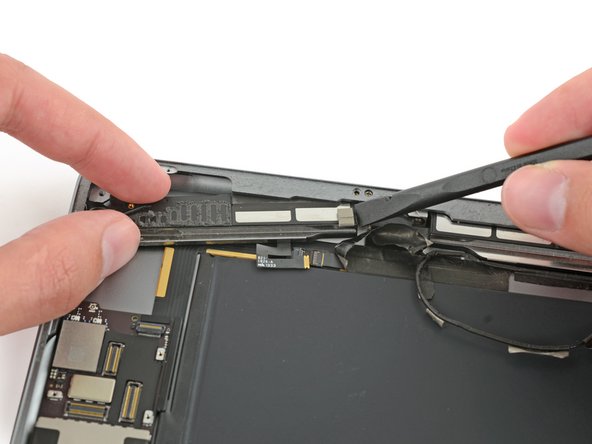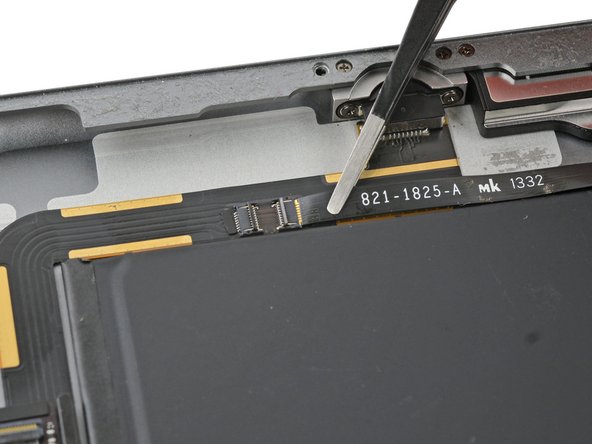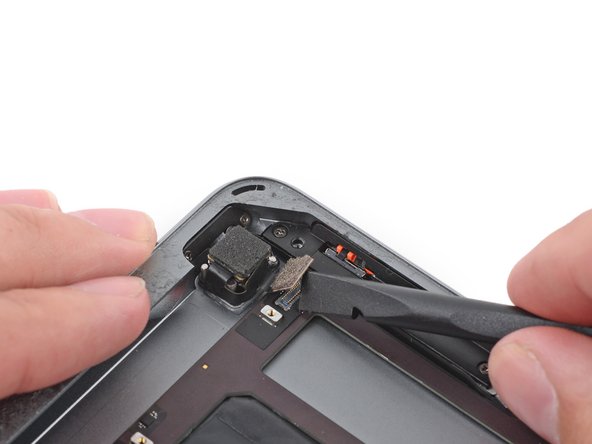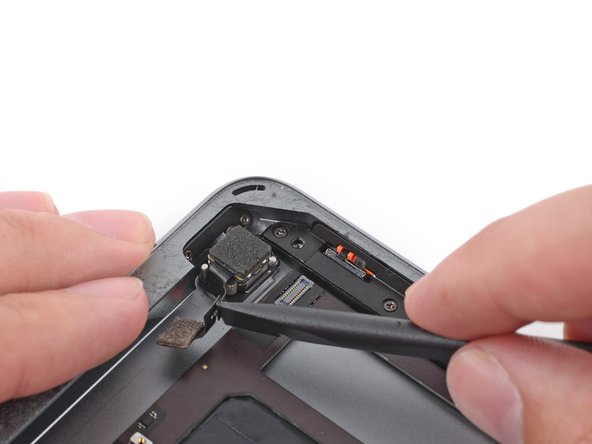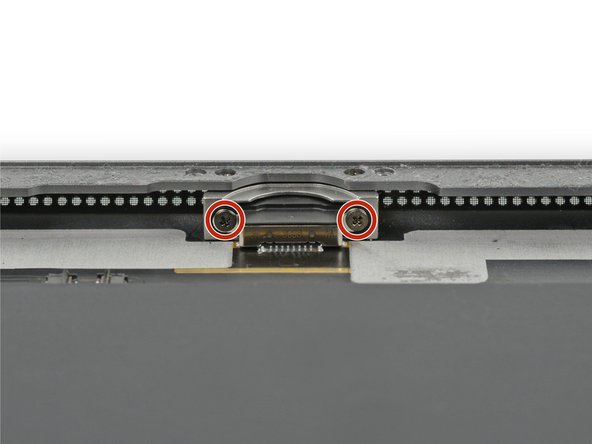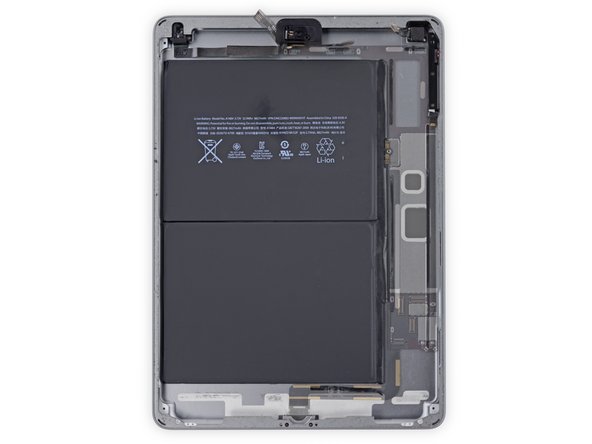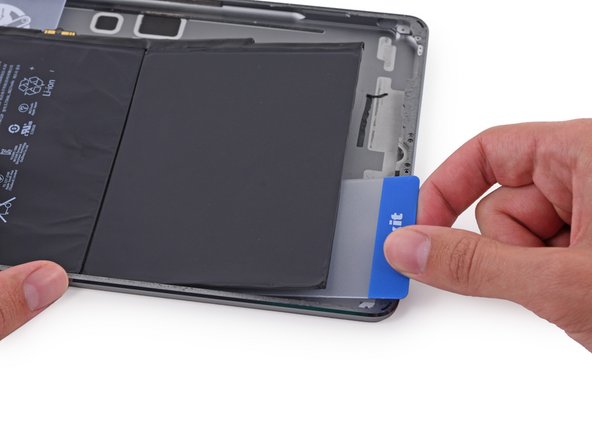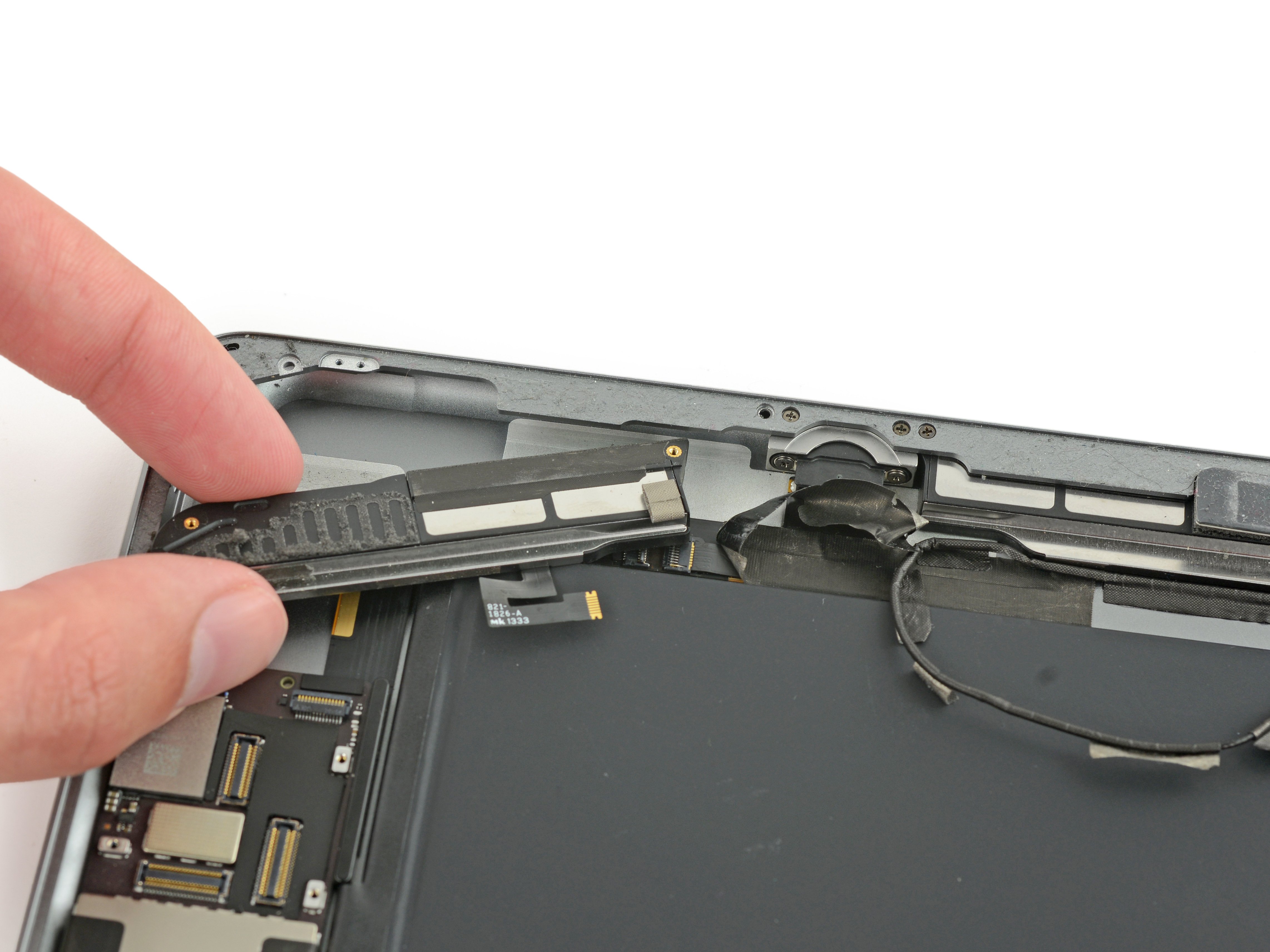iPad 6 Wi-Fi Battery Replacement
Duration: 45 minutes
Steps: 108 Steps
Handle the battery blocker with care – it's a delicate dance!
Ready to replace the battery in your iPad 6 Wi-Fi? First, if you notice that your battery is swollen, handle it with care! When using a battery blocker to isolate the battery, be extra cautious. The contacts are fragile, and a little slip could cause irreversible damage to the logic board. If you decide to skip isolating the battery, make sure to avoid using metal tools unless absolutely necessary (like for removing screws) to keep everything running smoothly and to avoid shorting the battery or messing with sensitive components. If you need help, you can always schedule a repair.
Step 1
- Warm up your iOpener and gently press it against the left edge of your device for a solid two minutes. Let the heat work its magic!
Tools Used
Step 2
- While you're waiting for the adhesive to loosen, be careful around these sensitive areas that don’t like to be pried on:
- Front camera
- Antennas
- Display cables
Step 3
The next three steps showcase the Anti-Clamp, a nifty little gadget we've cooked up to make your opening adventure a breeze. If you’re not using the Anti-Clamp, feel free to jump ahead three steps for an alternative approach.
Need a hand with using the Anti-Clamp? Check out this handy guide.
If your iPad's surface feels a bit too slick for the Anti-Clamp to get a grip, just slap on some tape to create a little more traction.
- Slide the blue handle back to release the Anti-Clamp’s arms.
- Prop up your iPad with something underneath so it sits evenly between the suction cups.
- Place the suction cups around the center of the left edge—one near the top, the other near the bottom.
- Keep the bottom of the Anti-Clamp steady and press down firmly on the top suction cup to get a good grip.
Step 4
- Give that blue handle a little tug forward to lock those arms in place.
- Now, twist that handle clockwise a full 360 degrees, or until you see those cups start to stretch out.
- Keep an eye on the suction cups to make sure they're still in sync. If they start dancing out of line, just loosen them up a tad and gently get those arms back on track.
Step 5
Take it easy! Only twist about half a turn at a time, and give it a minute to breathe between each twist. Let the Anti-Clamp and the magic of time do their thing for you.
Want to know how to use a hair dryer like a pro? Check out this guide for all the steps you need!
If the Anti-Clamp isn't giving you enough room to work, just add a bit more heat and twist the handle clockwise by half a turn. That should do the trick!
- Take a breather for about a minute to let that adhesive loosen up and create a nice little opening for you.
- If your screen seems a bit shy and isn't warming up enough, feel free to give it some love with a hair dryer along the left edge of the iPad.
- When the Anti-Clamp has worked its magic and there's a decent gap, gently slide an opening pick under the digitizer.
- Feel free to skip the next step.
Step 6
Got a seriously cracked screen? Slap on a layer of clear packing tape to give that suction cup something to grip onto. No tape? No problem! Use some strong adhesive tape instead to get the job done. And if all else fails, a dab of superglue can stick the suction cup right to the broken screen. Easy peasy!
- When the screen feels nice and toasty, grab a suction handle and stick it to the left edge of the screen—aim for the closest edge you can get.
- Gently lift the screen with the suction handle to open up a tiny gap between the digitizer and the frame.
- Slide an opening pick into that gap you just made, and carefully work your way around.
Tools Used
Step 7
No sweat if you spot the opening pick peeking through the digitizer—just slide it right out. The LCD should stay safe, but leaving adhesive behind can be a sticky mess to clean later.
- Pop in a second opening pick where you've created that gap.
- Gently slide the pick toward the bottom-left corner, breaking the adhesive seal.
- Leave the pick snug in the bottom-left corner to stop the adhesive from sticking back together.
Step 8
- If the opening pick gets caught in the adhesive, simply 'roll' it along the edge of the iPad to help continue separating the sticky stuff.
Step 9
- Gently slide the opening pick into the top-left corner of your device to break the adhesive seal. Easy does it!
- Once the pick is in place, leave it there to keep the adhesive from sticking back together.
Step 10
- Warm up an iOpener and stick it right on the top edge of your device, letting it chill there for two minutes.
Tools Used
Step 11
- Gently twist the pick around the top-left corner to loosen the adhesive without stressing the device.
Step 12
Steer clear of sliding the pick over the front camera; it's a surefire way to mess up that lens! Follow the upcoming steps to keep everything safe and sound.
- Gently glide the opening pick along the top edge of your device, making sure to pause just shy of the front camera's territory.
Step 13
- Gently pull the pick out until just the tip is snugly wedged between the digitizer and the frame.
- Slide the pick right above the front camera to break free that adhesive grip.
- Keep the pick hanging out near the right side of the front camera before you move on. You've got this!
Step 14
- Slide the pick back in and gently nudge it up towards the top-right corner to fully free up that stubborn top adhesive.
- Keep the pick wedged in the top-right corner to stop the adhesive from sticking back together while you work.
Step 15
- Warm up that iOpener and give it a cozy two-minute hug on the right edge of your device. It's like a spa day for your gadget!
Tools Used
Step 16
- Gently maneuver the pick around the top-right corner of your device to carefully break the adhesive seal. You've got this!
Step 17
The display cables are hanging out around the midway point of the iPad. Once you slide down about three inches from the bottom, it's time to stop and take a breather!
- Grab a fresh opening pick and slide it right into the heart of the iPad's right edge. You're on your way!
Step 18
- Warm up an iOpener and let it chill on the bottom edge of your device for a solid two minutes. This will soften things up and make the next step a breeze!
Tools Used
Step 19
Be careful not to fully twist the pick around the corner; you wouldn't want to accidentally harm the antenna.
- Gently slide the bottom-left pick into the corner to break free from that sticky adhesive grip.
- Keep the pick in place at the bottom-left corner before jumping to the next step.
Step 20
Slide the pick gently toward the home button, and steer clear of pushing it away. We don't want to accidentally mess with the antenna, right?
If you need to glide the pick over this spot again, just pull it out and pop it back in at the bottom-left corner to keep things smooth.
- Slide a fresh opening pick into the gap you just made along the bottom edge of the iPad.
- Gently glide the pick past the antenna, stopping just before you reach the home button.
- Pause with the pick resting to the left of the home button before moving on.
Step 21
Be sure to only slide that pick in a max of 1 mm—let's keep that right antenna safe and sound!
- Gently slide an opening pick into the little gap you've just made. You're doing great!
- Carefully maneuver the pick beneath the home button, gliding it towards the bottom-right corner. Just the tip should be nestled between the digitizer and the frame – keep it cozy!
Step 22
Slide the pick gently towards the home button, but avoid going the other way to steer clear of damaging the antenna. We believe in you, just take it slow!
If you need to slide the pick over this area again, just take it out and reinsert it at the bottom-right corner. You’ve got this!
- Slide the pick back in and glide it gently towards the home button to fully break through the bottom adhesive.
- Set the pick down just to the right of the home button before moving on.
Step 23
- Warm up your iOpener and gently press it against the right edge of the device for about two minutes. Give it some time to work its magic and loosen things up.
Tools Used
Step 24
Take your time with this step—go slow and steady. Make sure the adhesive is nice and warm so it’s easy to handle, and carefully separate all of it with a pick. If things get tricky, don’t hesitate to pause and reheat before moving on.
If you’re feeling a bit of a workout while prying, just reheat those edges and glide along with your trusty opening pick.
- Gently twist the two opening picks at the left corners of your iPad to lift the digitizer just a bit, helping to release the last bit of adhesive. You've got this!
Step 25
- Gently lift the left edge of the digitizer to help peel away the adhesive along the right edge of your iPad. You're doing great!
Step 26
- While holding the digitizer steady, gently slide an opening pick between the two display cables to break free the last of that pesky adhesive.
Step 27
- After you've successfully separated all that stubborn adhesive, gently open the digitizer like a book and lay it down parallel to the iPad. Nice and easy!
- As you gear up for reassembly, take a moment to tidy up! Use some isopropyl alcohol to wipe away any leftover adhesive from the frame—and from the digitizer if you're reusing it. Then, stick on some fresh adhesive strips or pre-cut adhesive cards to keep everything snug.
- Keep an eye on those display cables while you're putting the device back together. Fold them neatly under the LCD screen to avoid any mishaps. You've got this!
Step 28
- Carefully peel away any tape covering the LCD screws so you can get to the good stuff.
Step 29
- Unscrew the four Phillips #00 4.3 mm screws holding the LCD in place. Keep them safe!
Step 30
Don’t try to yank the LCD off completely! It’s still holding onto the iPad by a few cables around the home button. Focus on lifting it carefully from the front-facing camera side.
Take it easy and watch out for the LCD cables as you gently flip the display over. A little patience goes a long way here!
Gently place the LCD on a soft, clean, lint-free surface to keep it safe and sound.
- Use the flat side of your spudger to gently lift the LCD just enough so you can grab it with your fingers. Be mindful of any sticky glue around the screw holes—you might need to carefully slice through it with a knife.
- Next, flip the LCD like you're turning a page in a book. Start by lifting near the camera, and then slowly flip it over towards the home button side of the rear case.
- Place the LCD face down to give yourself easy access to the display cables.
Tools Used
Step 31
Check out these pics to see what the battery connector looks like beneath the logic board. Keep them handy as a guide while you carefully unplug the battery.
Heads up: the battery connector uses cantilever springs on the logic board that press against the battery’s contact pads. Since both the logic board and battery are glued down, you’ll want to slide something thin and flexible between the contacts to safely disconnect the battery.
Step 32
To keep things safe and avoid any short circuits, grab a battery isolation pick to gently disconnect the battery.
Be careful not to force the battery blocker under the connector. If it's giving you trouble, try using a playing card to disconnect the battery instead. It works like a charm!
The battery blocker or playing card should slide smoothly under the logic board, without any resistance. Once it's in, aim for a 15-degree angle for a snug fit.
- Unscrew the 2.3 mm Phillips #000 screw holding the battery connector to the logic board.
- Carefully slide the battery blocker underneath the logic board's battery connector at about a 35-degree angle.
- Keep the battery blocker in place while you continue working.
Tools Used
Step 33
- Unscrew the three 1.4 mm Phillips #000 screws holding the display cable bracket in place. You've got this!
Step 34
Be careful not to shove the spudger too deep under the bracket, as the display cable connector is glued down there. You wouldn't want to accidentally give it a bad day!
- Carefully slide the flat end of your spudger under the display cable bracket and pop it straight up off the logic board like a pro.
Tools Used
Step 35
- Time to say goodbye to that LCD! Carefully detach it from the device and set it aside. You're doing great!
Step 36
- Carefully peel away any tape that's hiding the home button ribbon cable connector.
Step 37
- Grab your trusty spudger and use the flat end to gently nudge that tab on the home button ribbon cable ZIF connector upward. You got this!
- Now, with a steady hand, carefully slide the home button ribbon cable straight out of the ZIF connector. Easy peasy!
Tools Used
Step 38
Hey there! Just a friendly reminder: when you're prying things apart, focus on the connectors themselves and steer clear of the socket on the logic board. Let's keep your iPad safe and sound!
- Gently use the flat end of a spudger or your fingernail to carefully pop the two digitizer cable connectors straight up out of their sockets.
- When putting everything back together, double-check that these connectors are fully and snugly seated in their sockets to avoid any pesky display problems.
Tools Used
Step 39
- Gently lift the home button ribbon cable off the adhesive that's sticking it to the rear case. You've got this!
Step 40
The insulation is sneaky—it's invisible to the naked eye and not to be confused with the foam dust barrier strips you often see on iPads.
- First up, let's get that front panel assembly off! Easy peasy.
- Now, if your shiny new display is acting a bit quirky with those pesky 'ghost' or 'phantom' touches, don't worry! You can fix it by adding a super thin layer of insulating tape—like Kapton tape—in the highlighted spots on the back of that panel. Good news: Salvation Repair panels come prepped with the right insulation, so you probably won’t need to add anything extra.
- Just a heads up: if those areas of the digitizer don’t have the right insulation, they might accidentally connect with other components and cause some touch input mayhem. Let's keep things running smoothly!
Step 41
- Carefully slide a spudger under the antenna cable near the iPad’s edge and gently lift it up to unplug the antenna cable connector.
Tools Used
Step 42
- You'll find two big strips of tape wrapped around the right antenna cable, holding it snug against the rear case.
- Carefully lift the tape up from the rear case.
- As you peel the tape, keep it stuck to the antenna cable—that way, putting it back together will be a breeze.
Step 43
The antenna cable is securely attached to the speaker using a small metal bracket. This bracket is tightly clamped onto the antenna and sticks to the speaker enclosure for a solid hold.
- Gently slide an opening pick between the speaker enclosure and the antenna cable bracket.
- Move the pick toward the home button to carefully slice through the adhesive.
- Nudge the bracket away from the speaker until it’s free from the tape underneath.
Step 44
- Grab your Phillips #000 screwdriver and remove these screws holding down the right antenna:
- One 2.3 mm screw
- Two 1.4 mm screws
Step 45
- Gently slide the flat end of your spudger between the antenna and speaker assembly like you're sneaking into a secret club.
- Carefully glide the spudger toward the home button to slice through the foam adhesive holding that antenna in place.
Tools Used
Step 46
- Gently pop off the right antenna from the iPad to keep things moving!
Step 47
- Slide a spudger beneath the left antenna cable and gently lift it up to unplug the antenna cable connector.
Tools Used
Step 48
- You'll notice five little pieces of tape snugly wrapped around the left antenna cable, giving a cozy hug to the right speaker cable connector. Time to break that tape party!
- Gently peel that tape away from the rear case—like you're unwrapping a gift!
- Now, let's fold that antenna cable out of the way so we can keep progressing on our repair adventure.
Step 49
If the speaker cable is bent, it can be tricky to lift the tape from the end. Keep that in mind while you work!
Handle your tweezers with care — focus on just grabbing and peeling the tape, and avoid snagging the cable underneath.
- Instead, hold onto the tape just below the speaker and gently peel it down, away from the edge of the case.
Tools Used
Step 50
- Gently peel back the tape towards the home button to reveal the speaker cable connector. You've got this!
Step 51
- Gently use the pointy end of your trusty spudger to lift the little flap holding the right speaker cable in place.
- Carefully slide the speaker cable straight out of its ZIF connector like a pro.
Tools Used
Step 52
- Peel away that tape that's keeping the speaker snug against the rear case. It's time to let it breathe!
Step 53
- Gently lift the LCD buffer tape off the back of the case, taking your time to avoid any mishaps.
Step 54
- Unscrew the 2.2 mm Phillips #000 screw holding the speaker onto the rear case. Keep it safe!
Step 55
- Slide your fingernail or the flat end of a spudger into the groove of the speaker housing, right by the corner of the rear case.
- Gently pull the speaker down and away from that corner of the case.
Tools Used
Step 56
- Grab a spudger and gently wiggle the speaker out from beneath the edge of the rear case.
- Carefully lift the right speaker away from the iPad.
Tools Used
Step 57
- Time to get your screwdriver out! Start by unscrewing the three 1.4 mm Phillips #000 screws that are holding down the upper component cable bracket. You've got this!
Step 58
If you're rocking the Wi-Fi/Cellular version, your iPad might look a tad different. Just a heads up, you'll need to take out two extra screws to get to those sneaky components hiding under this bracket.
- Take off that upper component cable bracket like a pro!
Step 59
- There are two pieces of tape still holding down the left antenna cable to the rear case.
- Gently peel the tape off from the rear case.
Step 60
- Gently slide an opening pick between the speaker enclosure and the antenna cable bracket—like sneaking into a VIP lounge.
- Carefully glide the pick toward the home button to slice through the adhesive holding things down.
- Nudge the bracket away from the speaker until it’s free from the tape hiding underneath.
Step 61
- Time to break out your trusty Phillips #000 screwdriver! Let's get those screws out of the way:
- Unscrew two of those tiny 1.4 mm screws – they’re the little guys.
- And don’t forget to tackle that single 2.3 mm screw – it’s a bit bigger, but you’ve got this!
Step 62
- Gently slide the flat end of your trusty spudger in between the antenna and the speaker assembly.
- Now, give that spudger a little nudge toward the home button to slice through the foam adhesive keeping the antenna nice and cozy.
Tools Used
Step 63
- Take off the left antenna from your iPad, just like peeling a banana. It's a simple step, and you're doing great!
Step 64
- Peel back the tape that’s keeping the left speaker cable connector under wraps.
Step 65
- Grab your trusty spudger and use its pointed end to gently lift the retaining flap on the left speaker cable connector. You've got this!
Tools Used
Step 66
- Gently slide the speaker cable straight out of its ZIF connector—nice and easy does it!
Step 67
- Carefully peel off the tape that’s keeping the speaker stuck to the rear case.
Step 68
- Unscrew the 2.2 mm Phillips #000 screw that’s holding the speaker in place on the back case. Keep it safe!
Step 69
- Carefully lift the left speaker ribbon cable upward so it stays out of the way when sliding the speaker enclosure out.
Step 70
- Slide your fingernail or the flat end of a spudger into the groove of the speaker housing, right near the rear case corner. You've got this!
- Gently pull the speaker down and away from that corner of the case. Easy peasy!
Tools Used
Step 71
- Grab your trusty spudger and carefully wiggle the speaker out from under the rear case edge.
- Gently lift the left speaker away from the iPad.
Tools Used
Step 72
Gently pry up just the connector—leave the socket alone, it’s not a fan of roughhousing.
- Gently use the flat end of a spudger to carefully disconnect the front-facing camera connector from the logic board. You've got this!
- Next, just fold the front-facing camera cable out of the way, making sure it’s nice and cozy.
- Keep in mind, there's a little bit of conductive adhesive hanging out between those shiny gold cable contacts. So, when you're putting everything back together, don’t forget to apply some pressure to help them stick together again.
Tools Used
Step 73
Lift gently on the connector only—avoid tugging on the socket itself to keep things happy!
- Grab your trusty spudger and use its flat end to gently detach the rear-facing camera connector from the logic board. You've got this!
- Now, just fold that rear-facing camera cable out of the way like a pro. Easy peasy!
Tools Used
Step 74
Gently lift the connector— steer clear of the socket itself!
On newer iPads, there’s a little tape loop attaching this connector to its socket on the logic board. You’ll need to carefully snip this tape to unplug the headphone jack. Keep it cool—you’ve got this!
- Gently pry up the headphone jack connector from the logic board using the flat end of your spudger.
- Carefully flip the headphone jack cable aside to keep it out of your way.
Tools Used
Step 75
Carefully pry up just on the connector—leave the socket itself alone!
- Gently pry the microphone cable connector off the logic board using the flat end of your trusty spudger.
Tools Used
Step 76
- Peel away any tape that’s hiding the upper button assembly cable connector. You’ve got this!
Step 77
- Take the pointy tip of your spudger and gently flip up the little retaining flap on the upper button assembly cable connector. Easy does it!
Tools Used
Step 78
- Gently slide the upper button assembly cable straight out from its ZIF connector like a pro unplugging a charger!
Step 79
To spot those screws, hold your iPad upright and take a peek down at the Lightning port.
- Unscrew those two 3.3 mm Phillips #000 screws that are holding down the Lightning port. You've got this!
Step 80
Next up, it's time to bring the heat! Grab your trusty iOpener and apply it to the back of your iPad. This will help loosen up that sticky adhesive keeping the logic board snug as a bug.
As you reheat and position the iOpener in the suggested spots, make sure to give it at least a minute in each location. This way, the adhesive can get nice and soft, ready for the next step!
- The adhesive comes as six strips of black foam tape—keep this step handy while you gently heat and pry, so you know exactly where each piece lives.
Tools Used
Step 81
It's totally fine if you need some extra time, but if you leave your iOpener on the rear case for too long, just give it a quick reheat and reapply it. Simple as that!
- Set a warm iOpener over the back camera side of the iPad and let it chill there for at least a minute to loosen up that stubborn adhesive hiding under the rear case.
Tools Used
Step 82
As you dive into the next few steps, when you're prying away the adhesive holding the logic board snug, remember to start off gently to check if the adhesive has decided to loosen up. If it’s still playing hard to get, give your iOpener a little reheat and place it back on the rear case for some extra warmth.
- Gently slide an opening pick under the logic board, right between the front-facing camera and the battery.
- Ease the pick forward toward the front-facing camera connector, and pause when you hit the bend in the logic board.
Tools Used
Step 83
- Gently slide an opening pick underneath the logic board, starting from the front-facing camera area and moving toward the rear-facing camera.
Step 84
Give the iOpener a little time-out! Let it chill for at least a minute to help soften that adhesive lurking beneath the rear case.
- Warm up an iOpener and set it along the bottom edge of your iPad to get things cozy.
Tools Used
Step 85
The Lightning connector cable is glued down to the case with some adhesive. To separate it, gently slide an opening pick between the cable and the case. Take care not to nick or slice the Lightning connector cable while you work.
- Carefully slip an opening pick under the Lightning cable right where it connects to the logic board.
- Gently slide the pick down and guide it around the cable’s bend.
Step 86
Take it slow and steady! If your opening pick isn’t sliding in like butter, warm it up a bit more and give it another go. Pushing too hard might cause you to slip and cut the Lightning connector cable, and that’s a no-go.
- Keep on sliding that opening pick right under the cable, but make sure to stop before it bends towards the Lightning connector. You've got this!
Step 87
- Gently slide the opening pick between the battery and the Lightning connector to carefully loosen the last bit of adhesive holding that cable in place.
Step 88
- Gently pull the Lightning connector straight out from its spot in the rear case—easy does it!
Step 89
Give the iOpener at least a minute to work its magic and loosen up that adhesive on the back case.
- Warm up your iOpener and place it on the left side of the rear case, right where the logic board is sticking around. Let's get that case cozy!
Tools Used
Step 90
- Slip a plastic opening tool into the rectangular gap near the top of the logic board, then gently pry it up away from the rear case.
- Keep the tool tucked under the logic board and carefully slide it down the gap to loosen the upper edge from the adhesive holding it in place.
Step 91
Gently lift the end of the logic board. If you hit any serious resistance, take a step back, stop prying, and give the iOpener another go. Patience is key!
- Gently lift the logic board from the lower edge of the rectangular gap, just by the EMI shield. You've got this!
Tools Used
Step 92
Heads up! Be super careful not to slice into the battery with your opening pick — a punctured battery is no joke. If things get stuck, just warm it up again with the iOpener and try once more.
- Gently slide an opening pick under the logic board, finding a cozy spot between it and the battery.
- Carefully glide that pick from the base towards the center of the logic board to break free the adhesive holding it in place.
Tools Used
Step 93
- Gently slide the pick along the entire length of the logic board.
- After the adhesive is sliced through, carefully lift the battery side of the logic board up and away from the rear case.
Step 94
- Gently lift the logic board from the edge closest to the battery, making sure to slide an opening pick against the far edge of the logic board when you have enough space.
- Carefully slice through any adhesive that’s keeping the outer edge of the logic board stuck to the rear case.
Step 95
- Gently take out the logic board from the iPad.
Step 96
Heads up: don’t let the iOpener get too toasty! Give it at least two minutes to cool down before warming it up again, and never zap it in the microwave for more than 30 seconds.
These steps guide you through using heat to loosen up the glue holding the battery in place. If you want to play it safer, try slipping a solvent like adhesive remover between the battery and the back case to gently break down the glue.
Heads up: the iOpener might lose its warmth between uses—if it cools off, just pop it back in the microwave for another 30 seconds before moving on.
- Heat up the iOpener in the microwave for 30 seconds to get things warm and ready.
- Set the warm iOpener right in the middle of the iPad's back and chill for 90 seconds to soften that stubborn battery glue.
- Slide the iOpener over to the right side, steering clear of the rear camera, and let it hang out for another 90 seconds.
- Finally, move the iOpener to the right edge of the iPad and give it one more 90-second session to finish softening.
Tools Used
Step 97
As you dive into this process, you'll be sliding some nifty plastic cards between the battery and the rear case of your iPad, working to gently separate the adhesive that's holding the battery in place. Remember to keep those cards nice and flat to avoid bending the battery—nobody wants a damaged battery releasing any unwanted surprises!
If you're feeling some stubborn resistance, no worries! Give your iOpener a quick reheat and try again. That extra heat will help the adhesive loosen up, making things smoother for the next step.
- Slide a plastic card into the lower battery cell, starting from the lower right-hand corner. You're doing great!
Tools Used
Step 98
- With the card inserted about halfway, gently slide it towards the top of the iPad, but make sure to stop just before reaching the battery contact post. Keep it smooth and steady!
Step 99
- Gently lift the card up just enough to clear the battery contact mounting post on the rear case.
- Carefully slide the card starting from the middle of the battery cells over to the upper right corner of the battery.
Step 100
- Slide a second plastic card about halfway under the left battery cell to keep it from sticking back when you pop the iOpener back on.
Tools Used
Step 101
- Set an iOpener on the right side of the battery, opposite the cards, to help soften the adhesive and make it easier to lift.
Tools Used
Step 102
- Gently glide that card around the lower right corner of the battery, making sure to give it a little love as you go!
Step 103
- Gently glide that trusty plastic card down to the lower left corner of the battery like you're sliding into home base!
Step 104
- Gently nudge that card further in, giving a little help to break up the adhesive that's keeping the battery snug as a bug.
- Slide the plastic card under the lower left corner of the battery like you're tucking it into bed.
Step 105
Take extra care as you glide the card over the front-facing camera and headphone jack cables to keep them safe and sound.
- Gently glide the card around the top right corner of the battery like you're giving it a friendly nudge.
Step 106
Carefully slide the card under the front-facing camera and headphone jack cables to keep them safe and sound—no snips allowed!
- Gently nudge that plastic card towards the upper left corner of the battery and watch it work its magic!
Step 107
- Push the card in a bit more to slice through as much of the sticky battery glue as possible.
- Slide the plastic card under the top left corner of the battery.
Step 108
- Hold onto both cards like a pro and give them a twist to pop that battery off the back case.
- Carefully lift the battery out from the rear case.
















































































